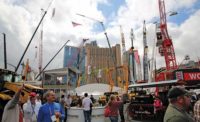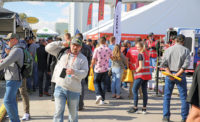This year, the overriding mood of the triennial CONEXPO-CON/AGG equipment trade show was one of guarded optimism. Crowds poured into the Las Vegas Convention Center on March 7-11, but many were window-shopping. Equipment manufacturers brought out their latest machines with the highest-tech solutions but also were careful to offer more economically priced items for the rental customer. It was a record-sized show, but some of the biggest draws were displays of far-in-the-future technology.
Attendance at the show topped the 2014 event head count, with nearly 128,000 people walking the show floor. Attendees included an 8% increase in buyers over 2014, according to show organizers.
“Exhibitors are writing sales at an incredible pace, and attendees clearly came to Las Vegas to buy,” said 2017 CONEXPO chair Rich Goldsbury, also CEO and president of Doosan Bobcat’s North America and Oceania division.
Making up roughly 20% of the audience and facing a strong dollar and export costs, the show’s international attendees could indicate broader global growth in the equipment market. “Last year, the global market overall fell 5%, and we feel very strongly that was the bottom of the cycle,” Chris Sleight, senior consultant with U.K.-based Off-Highway Research (OHR), told ENR. “This year, we’re looking at probably 7% global growth overall.” OHR forecasts sales of more than 695,000 pieces of equipment in 2017, surpassing the estimated 650,133 pieces of equipment sold in 2016. Looking at the U.S. market, OHR attributed slow sales growth in 2016 to nervousness over the presidential election and expects steady growth in U.S. equipment sales in the next few years.
Article Index:
U.S. Equipment by the Numbers
Commissioned by the Association of Equipment Manufacturers and released at CONEXPO, a study estimates that, in 2016, direct and indirect sales of off-highway equipment and ancillary products contributed to the U.S. economy $416.2 billion, out of approximately $31.3 trillion in total sales activity in the U.S. from all economic sectors.
AEM’s study, conducted by IHS Economics, measures the economic contribution the industry makes to the broader economy in terms of jobs supported, contribution to GDP and taxes.
“Looking forward, we see improving fundamentals for the construction, agriculture and equipment industries,” says Scott Hazelton, IHS managing director.
While the study illustrates that, in 2016, the equipment industry directly employed 424,000 people to produce off-highway equipment in the U.S., the industry supported 1.3 million workers when indirect and induced employment contributions are included, Hazelton says. Average income for those directly employed topped $78,000—58% above the national average.
AEM plans to use the data to lobby the Trump administration and Congress. “This report makes clear that a major infrastructure package would be of significant benefit to the equipment manufacturing industry and, thus, the whole economy of the U.S.,” says Michael Haberman, AEM chairman and president of Gradall Industries Inc.
AEM also will push for tax reform and loosened regulatory requirements. “Tax reform can have very a good capital influx on our business and our customers’ business,” Haberman says. “If the tax burden is lifted, there are quite a few customers that wouldn’t mind an extra machine.”
R&D Efforts Change Up Ordinary Iron
Equipment sales have been slow in recent years. A drop in construction due to the Great Recession was followed by an upward creep in prices to absorb the shift to Tier 4 Final emissions standards. But with signs of recovery in U.S. construction spending and possible renewed public investment in infrastructure, equipment makers rolled out new compact and small crossover machines to show potential buyers what they have been working on in the lab.
Case Construction Equipment launched the DL450, a compact track loader with a full dozer blade and linkage. Code-named Project Minotaur, it is only a concept machine and will not be available until next year, at the earliest. “It’s a very practical evolution of two product lines,” says Scott Harris, Case CE vice president for North America. “It provides the power and performance of a small dozer in a platform that will also work as a loader and run the attachments that a contractor currently owns for their skid steers and compact track loaders.”
JCB turned some heads at its booth with the TeleSkid, a compact skid-steer wheel loader with a telescopic boom. The machine can extend its reach farther than comparable CTLs or skid-steers and dig one meter below its chassis, an industry first. “The industry is by nature fairly conservative. But when customers see a machine that can do what no other machine can do, it’s fairly easy to convince them to go and sit and buy the machine,” says JCB CEO Graeme MacDonald.
“Already, we’ve seen a lot of interest in the TeleSkid, so I’m convinced we can not only take more share of the market but actually grow the market itself.”
Innovative designs weren’t limited to compact equipment at the show. While large heavy equipment, such as excavators and wheel loaders, updated emissions controls and fuel-saving measures, the work-truck market saw some new developments. Ardco unveiled the AMT 400 and AMT 600 articulated, multipurpose trucks that easily can swap out different work bodies as needed. The two-seater articulated truck chassis can accept a wide range of work bodies, including a flatbed, water tank, drill bed, dump bed or a fuel-and-lube set. The different beds can be switched using only a crane or forklift.
Global Equipment Looks to Growth
In a reversal from recent years, activity in China is a bright spot in global equipment sales. “China is seeing a genuine recovery. There’s some solid investment plans going on in China now,” says OHR’s Sleight. “We’ve seen—last quarter of last year and first couple of months of this year—that excavator sales, in particular, have gone up very steeply.”
Zeng Guang’an, chairman of China-based Liugong Machinery Co., echoed this point of view. “In the past five years, the global construction equipment market has changed, especially in China,” he told reporters at CONEXPO. “In the last half of 2016, the market in China was booming, and, in the first two months, our excavator orders have seen a 300% increase.”
Zeng attributed this turnaround to government investment, urbanization and China’s recovering mining sector. “We believe that we will continue to see strong demand for the next few years,” he said.
“The jump in [Chinese excavators] is probably a blip, but it does follow a trend of growth,” observes Sleight, who notes that there is still a long way to go. “In five years, China might get to 170,000 machines [sold a year], but, in 2011, it was nearly half a million pieces of equipment. There is distress there and overcapacity.”
But with China recovering and positive signs in India and Japan, predicted U.S. construction growth may be only a single component of a broader global rise in equipment sales, Sleight says.
|
Las Vegas Growth Spurs $3B in Road Projects Underway in Clark County |












Post a comment to this article
Report Abusive Comment